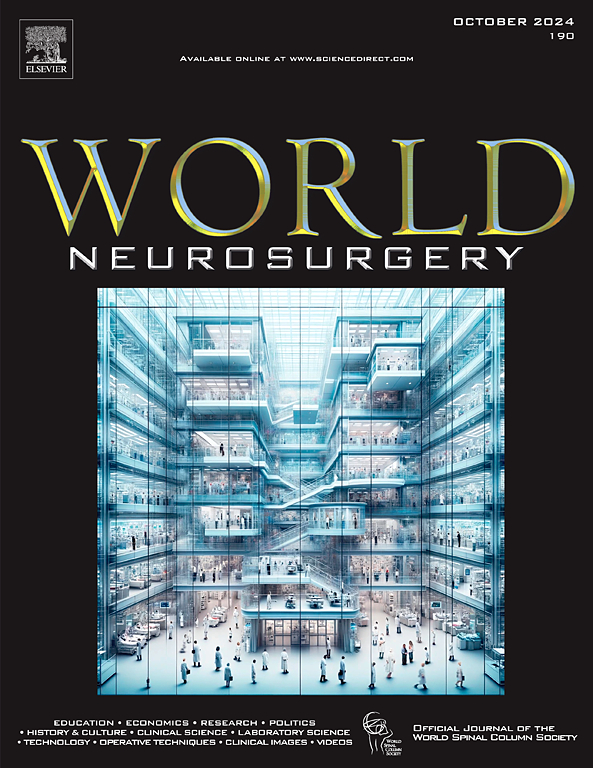Volume of Operative Maneuverability as a New Measurement in Neuroanatomical Research: A Methodological Quantitative Study and Translational Use in the Operating Room
IF 1.9
4区 医学
Q3 CLINICAL NEUROLOGY
引用次数: 0
Abstract
Objective
The lack of standardized metrics in neuroanatomical research limits the objective assessment of neurosurgical approaches. We introduce a novel volume-based parameter, the Volume of Operative Maneuverability (VOM), and evaluate its utility in quantifying surgical corridor dimensions.
Methods
Seven microscopic and endoscopic skull base approaches were performed on 4 embalmed latex-injected human cadaveric specimens. A spatial principal component analysis algorithm converted surgical entry and target areas into ellipses, allowing ellipsoidal-based VOM calculations. Corridor length (“target distance”) and a fixed 10 mm distance from the target (“standardized VOM” [sVOM]) were also measured. Feasibility and reproducibility were assessed using three-dimensional photogrammetry, preoperative imaging models, and a clinical case.
Results
Endoscopic endonasal and anterior transmaxillary approaches offered sufficient corridor volume and trajectory distance but created longer, narrower surgical corridors with lower sVOM than transcranial approaches. Conversely, pretemporal-orbitozygomatic and subtemporal corridors showed the highest VOM and sVOM. Illustrative examples confirmed consistent measurement in photogrammetry and preoperative imaging. A clinical case involving a right spheno-cavernous meningioma demonstrated a VOM of 2.328 cm³, sVOM of 0.615 cm³, and a target distance of 18 mm during extradural anterior clinoidectomy.
Conclusions
VOM provides a quantitative, reproducible metric for assessing surgical maneuverability toward irregular target surfaces, overcoming the limitations of traditional qualitative assessments. Preliminary data support its use in quantitative neuroanatomical research and suggest potential integration into surgical planning and intraoperative data collection.
手术可操作性体积(VOM)作为神经解剖学研究中的一种新测量方法:方法学定量研究及其在手术室中的转化应用。
目的:神经解剖学研究中缺乏标准化的指标限制了神经外科入路的客观评估。我们引入了一种新的基于体积的参数——手术可操作性体积(Volume of operoperability, VOM),并评估了它在量化手术通道尺寸方面的效用。方法:对4例经乳胶注射的尸体标本进行7次显微及内镜颅底入路检查。空间主成分分析算法将手术入口和目标区域转换为椭圆,允许基于椭球体的VOM计算。走廊长度(“目标距离”)和与目标的固定10mm距离(“标准化VOM”,sVOM)也被测量。通过三维摄影测量、术前成像模型和临床病例评估可行性和重复性。结果:内镜下经鼻和前上颌入路提供了足够的通道容量和轨迹距离,但与经颅入路相比,sVOM较低的手术通道更长、更窄。相反,颞前眶颧和颞下通道显示最高的VOM和sVOM。说明性的例子证实了摄影测量和术前成像的一致测量。1例右侧蝶海绵状脑膜瘤临床表现为硬膜外前突切除术时,VOM为2.328 cm³,sVOM为0.615 cm³,靶距为18 mm。结论:VOM提供了一种定量的、可重复的指标来评估不规则靶面的手术可操作性,克服了传统定性评估的局限性。初步数据支持其在定量神经解剖学研究中的应用,并建议将其整合到手术计划和术中数据收集中。
本文章由计算机程序翻译,如有差异,请以英文原文为准。
求助全文
约1分钟内获得全文
求助全文
来源期刊

World neurosurgery
CLINICAL NEUROLOGY-SURGERY
CiteScore
3.90
自引率
15.00%
发文量
1765
审稿时长
47 days
期刊介绍:
World Neurosurgery has an open access mirror journal World Neurosurgery: X, sharing the same aims and scope, editorial team, submission system and rigorous peer review.
The journal''s mission is to:
-To provide a first-class international forum and a 2-way conduit for dialogue that is relevant to neurosurgeons and providers who care for neurosurgery patients. The categories of the exchanged information include clinical and basic science, as well as global information that provide social, political, educational, economic, cultural or societal insights and knowledge that are of significance and relevance to worldwide neurosurgery patient care.
-To act as a primary intellectual catalyst for the stimulation of creativity, the creation of new knowledge, and the enhancement of quality neurosurgical care worldwide.
-To provide a forum for communication that enriches the lives of all neurosurgeons and their colleagues; and, in so doing, enriches the lives of their patients.
Topics to be addressed in World Neurosurgery include: EDUCATION, ECONOMICS, RESEARCH, POLITICS, HISTORY, CULTURE, CLINICAL SCIENCE, LABORATORY SCIENCE, TECHNOLOGY, OPERATIVE TECHNIQUES, CLINICAL IMAGES, VIDEOS
 求助内容:
求助内容: 应助结果提醒方式:
应助结果提醒方式:


